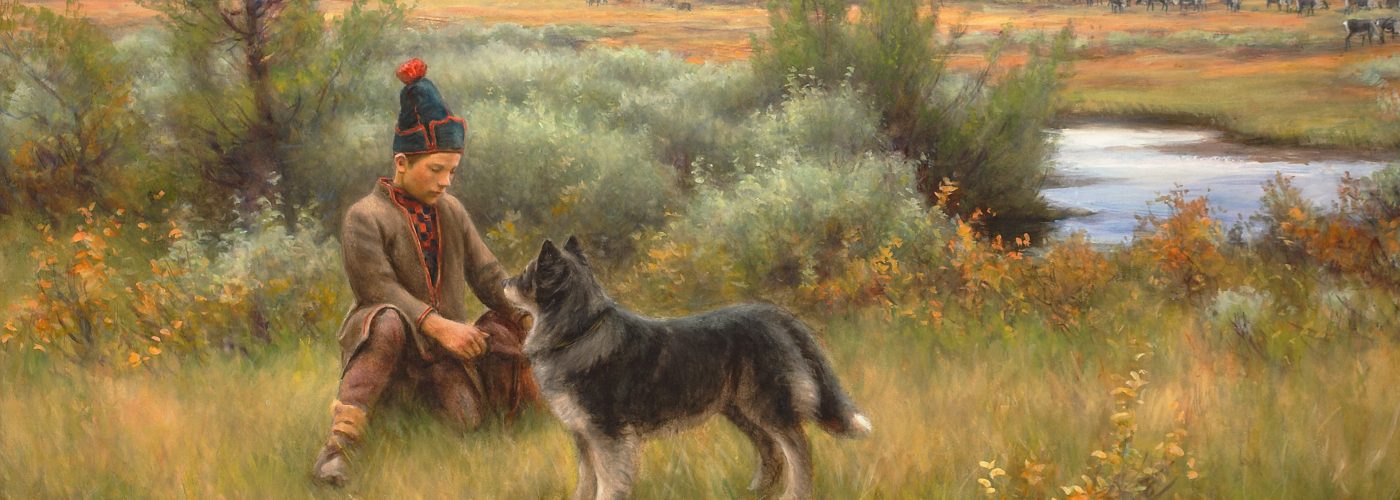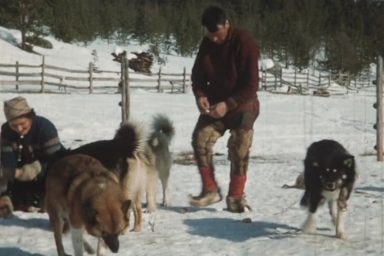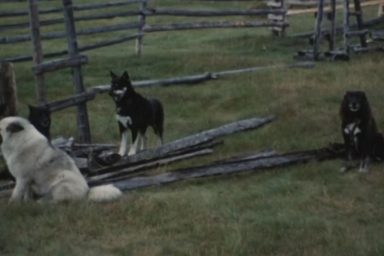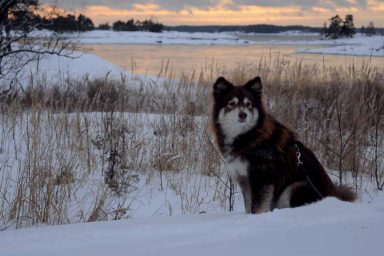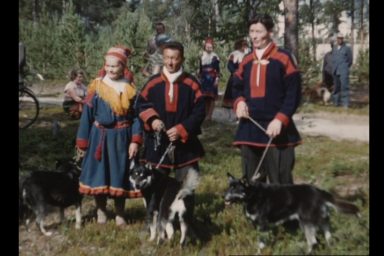Large-scale reindeer husbandry developed in the 1700s. At the same time, wild reindeer hunting declined. The turn of the 17th and the 18th century was a clear boundary marker between the hunting and the herding Lappish dogs. The hunting dog had to adapt to its new job as a reindeer herder.
During the 18th century, small-scale reindeer herding (Forest Sámi) developed in many places into year-round nomadic reindeer husbandry (Reindeer Sámi). Herds grew, and the workload increased. The number and value of dogs increased, because people could not cope with the work without their four-legged friends.
Sámi families started considering dogs as their most important assets. Good reindeer dogs cost a fortune, and a family’s wealth and status was measured by their number of both reindeer and dogs. Nowadays, year-round reindeer husbandry is most typical to Western and North-Western Lapland.
Many kinds of herding dogs
Already in the 1800s, the reindeer herding area extended all the way across Northern Scandinavia to the Kola Peninsula. Cultures, peoples, and livelihoods varied, but reindeer herding was the predominant way to bring food to the table. All the dogs in the reindeer herding area were arctic spitz, but their appearance and manner of herding could be quite different.
The most important task of the Lappish dogs was to help guard and transport large reindeer herds to different pasturelands, according to the season. The herding and guarding tasks were varied, and the dogs had to be brave, cooperative, and independent. They had to be able to work in the expansive fell landscape without their owner’s constant guidance.
When large herds were moved from place to place, the dogs of different herding cultures mixed together. In some places, herding by barking was emphasized; other ways elsewhere. The dogs were free to breed together, and the working dog stock of Lapland was dynamic and diversified. But they were not yet distinct breeds.
At that time, ‘dog name lists’ were published. The first mentions of Lappish herding dogs are from 1891.
The Sámi’s area inside Finland was expanded, and partially for this reason, organized national kennel activities were begun in the late 1800s. The first Finnish dog show was organized the following year, and Lappish dogs participated under the names Lapland’s Herding Dogs, Laplander Dogs, and Reindeer Dogs. The same dogs were sometimes even called Finnish Barking Bird Dogs, even though over time a whole new breed was created from bird dogs, the Finnish Spitz.
Although many groups in society were interested in the primitive dog breeds, no actual breeding was being done. The Lappish breeds were not differentiated, and the main focus was on developing the Finnish Spitz. General interest in the northern regions and wilderness brought hunters up north from Southern Finland, who brought with them their own hunting dogs, which cross-bred with the reindeer-herding dogs.
From the prime to war-time
By the end of the 19th century, wild reindeer and wild forest reindeer had virtually disappeared from Finland. The wild reindeer that survived all the hunting blended with the semi-domesticated reindeer, and the early 1900s are considered the golden age of reindeer husbandry. There were many kinds of dogs in Lapland, and their status was stable. Dogs eased people’s work load and made it possible to maintain larger herds. Dogs could control reindeer just as well in open terrain or snow as in dense birch forests or on a fell.
In Southern Finland, there were dogs called Lapland’s Spitz and Lapland’s Herding Dogs in the 1930s. Interest in our original, native herding dog breed increased, and Lappish dogs weren’t only used as reindeer herders: in the southern parts of the reindeer herding area, they drove stray reindeer out of farmers’ fields, gardens, and pastures for cattle. The reindeer herding dogs of the Fell Sámi in Enontekiö were considered the earliest dog type.
Swedish breeders registered their own Lapphund in the mid-1930s. Finnish kennel associations had the same objective, but they wanted to avoid the mistakes that the Swedes made. The Swedish Lapphund had very little to do with the traditional herding dogs of Northern Sweden. The breed had been created in the south, and it no longer met the requirements of a working dog.
The breeding objectives of Finnish kennels had not yet made a real influence before the Second World War broke out. The Lapland War, fought in the aftermath of WW2 (1944-1945), almost annihilated the Lappish dog population. Dogs weren’t allowed aboard the evacuation trains to Southern Finland, and people preferred shooting them to leaving them to be caught in the fighting. Original reindeer dogs survived only in remote villages far from the war.
THE DOGS OF THE FOREST AND REINDEER SÁMI
The Forest Sámi made their living from hunting and small-scale reindeer herding. They herded their few reindeer mainly during winter, but in the summer, the animals were free to roam the family’s extensive pasturelands. Their reindeer were a source of milk and meat, and they used them as draught animals and decoys for hunting wild reindeer. Dogs were used for many tasks: hunting, guarding domestic animals, and herding reindeer in the winter. The Reindeer Sámi lived mainly from reindeer herding. Dogs were used year-round for herding reindeer, but the same dogs probably also guarded the home and participated in hunting. Their herds of reindeer were large, and they only kept a few tame ones at home as draught animals. The dogs of the Reindeer Sámi were like family members: they lived closely with their owners, ate the same food, and slept inside their goahtis (tepee-like portable abodes).
Source: Dogs of Lapland – Cheerfully present (2012). Lappalaiskoirat ry. Kirjakaari, Jyväskylä.
Main picture: Johan Tirén (1853-1911). Samepojke leker med sin hund. Year unknown.
